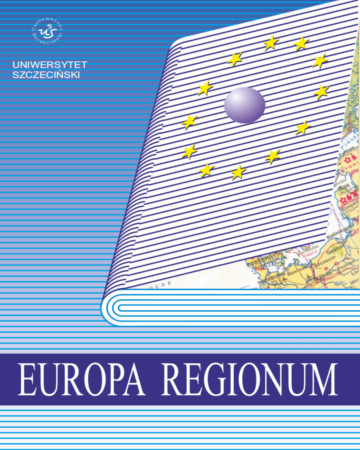
ISSN: 1428-278X
OAI
DOI: 10.18276/er.2017.33-12


Issue archive /
t. 33 2017
ROLA FUNDUSZY UNIJNYCH W PODNOSZENIU INNOWACYJNOŚCI ŁOTEWSKIEJ GOSPODARKI
(The role of EU structural funds in improving in novativeness of Latvian economy)
| Authors: |
Jakub
Sawulski
Uniwersytet Ekonomiczny w Poznaniu Katedra Finansów Publicznych |
| Keywords: | innovation R&D efficiency |
| Data publikacji całości: | 2017-12-31 |
| Page range: | 10 (127-136) |
| Klasyfikacja JEL: | O38 O30 F35 |
Abstract
Latvia was one of the EU countries strongly affected by the global financial crisis. During a deep recession in years 2008–2010, public authorities significantly reduced public funds for science and introduced new system of financing for this sector. These reforms coincided with growing inflow of EU structural funds for innovation. As a result, whole science sector faced important changes in the way of financing of research activities. The aim of the article was to answer the question, how the described changes in Latvian innovation policy influenced the efficiency of R&D expenditure in the economy. Firstly, the economic situation in Latvia in years 2004–2014 was pictured, and the evolution of R&D expenditure structure was analysed. Secondly, selected programs of support for science sector from EU structural funds were described. Thirdly, using the statistical data the efficiency of R&D expenditure in Latvian economy in three time periods – pre-crisis, during crises and post-crises – was evaluated. T he study shows that the results of R&D activity in Latvia (the number of scientific publications, the number of patents to European Patent Office and the value of high-technology exports) in relation to the amount of R&D expenditure were clearly higher in the years following the financial crisis than before and during the crisis. In post-crises period the calculated R&D efficiency ratios were also higher than the average in other EU countries. T he research may have some implications for public policies. Firstly, it has confirmed the rightness of measures taken in many countries in recent years to replace the institutional funding of research organisations by project funding. Secondly, it suggests that high share of foreign funding in R&D budgets positively influences the R&D expenditure efficiency. Thirdly, Latvian case shows that the development of human capital for R&D sector should play an important role in public policies for innovation. Finally, the results of the study may also be a part of the discussion on the role of the recessions in the process of economic development, as the experience of the Latvian economy shows that the crisis may be a good moment and a stimulus for conducting pro-efficient reforms in the R&D sector.
Download file
Article file
Bibliography
| 1. | Adamsone-Fiskovica, A., Draveniece, A., Kristapsons, J. (2013). Erawatch Country Reports 2011: Latvia. Seville: European Commission. |
| 2. | Advanced Social and Political Research Institute (2011). Latvia. Human Development Report 2010/2011. Riga: University of Latvia. |
| 3. | Cunska, Z., Ketels, Ch., Paalzow, A., Vanags, A. (2013). Latvia Competitiveness Report. Riga: Baltic International Centre for Economic Policy Studies. |
| 4. | Deloitte (2014). Researchers’ Report 2014. Country Profile: Latvia. Riga: Deloitte. |
| 5. | European Commission (2014). Research and Innovation performance in Latvia. Brussels: European Commission. |
| 6. | European Commission (2015). Innovation Union Scoreboard 2015. Brussels: European Commission. |
| 7. | Eurostat (2017). Eurostat Statistical Database. Pobrano z: http://ec.europa.eu/eurostat/data/database (10.10.2017). |
| 8. | Goto, A., Suzuki, K. (1989). R&D Capital, Rate of Return on R&D Investment and Spillover of R&D in Japanese Manufacturing Industries. The Review of Economics and Statistics, 4 (71), 555–564. |
| 9. | Hsu, F.J., Chen, M.Y., Chen, Y.C., Wang, W.C. (2013). An Empirical Study on the Relationship between R&D and Financial Performance. Journal of Applied Finance & Banking, 3 (5), 107–119. |
| 10. | ICF (2015). ESF 2007–2013 Ex-post Evaluation: Investment in Human Capital. Brussels: European Commission. |
| 11. | Kancs, D., Kielyte, J. (2010). Education in the East, Emigrating to the West? European Review, 2 (18), 133–154. |
| 12. | Kulikovskis, G., Petraityte, D., Stamenov, B. (2016). RIO Country Report 2015: Latvia. Seville: European Commission. |
| 13. | Lykogianni, E., Verbeek, A. (2008). A Time Series Analysis of the Development in National R&D Intensities and National Public Expenditures on R&D. Brussels: IDEA Consult. |
| 14. | Metis GmbH (2016). ESF Ex-post Evaluation Synthesis 2007–2013. Country Report – Latvia. Brussels: European Commission. |
| 15. | Ministry of Education and Science (2012). Project Application Evaluation Criteria. 1.1.1.2. Attraction of Human Resources to Science. Open Selection of Project Applications (2nd call). Riga: MES. |
| 16. | Ministry of Education and Science (2016). Latvian European Research Area Roadmap 2016–2020. Riga: MES. |
| 17. | OECD (2015). OECD Economic Surveys – Latvia. Paris: OECD. |
| 18. | SCImago (2017). SJR – SCImago Journal & Country Rank. Pobrano z: http://www.scimagojr.com (10.10.2017). |
| 19. | Sursock, A. (2016). Latvian doctoral studies and promotion system. Riga: World Bank. |
| 20. | Ubelis, A. (2014). Erawatch Country Reports 2013: Latvia. Seville: European Commission. |
| 21. | Veugelers, R. (2014). Undercutting the Future? European Research Spending in Times of Fiscal Consolidation. Brussels: Bruegel. |
| 22. | World Bank (2017). World Development Indicators. Pobrano z: http://databank.worldbank.org (10.10.2017). |
| 23. | World Economic Forum (2009). The Global Competitiveness Report 2009–2010. Geneva: WEF. |
| 24. | World Economic Forum (2014). The Global Competitiveness Report 2014–2015. Geneva: WEF. |
| 25. | Yang, J., Jeong, B.H., Cheon, K. (2011). Finding the Time Lag Effect of the R&D Activity for a Government Research Program of Korea. Dalian: 2011 International Conference on Asia Pacific Business Innovation and Technology Management. |